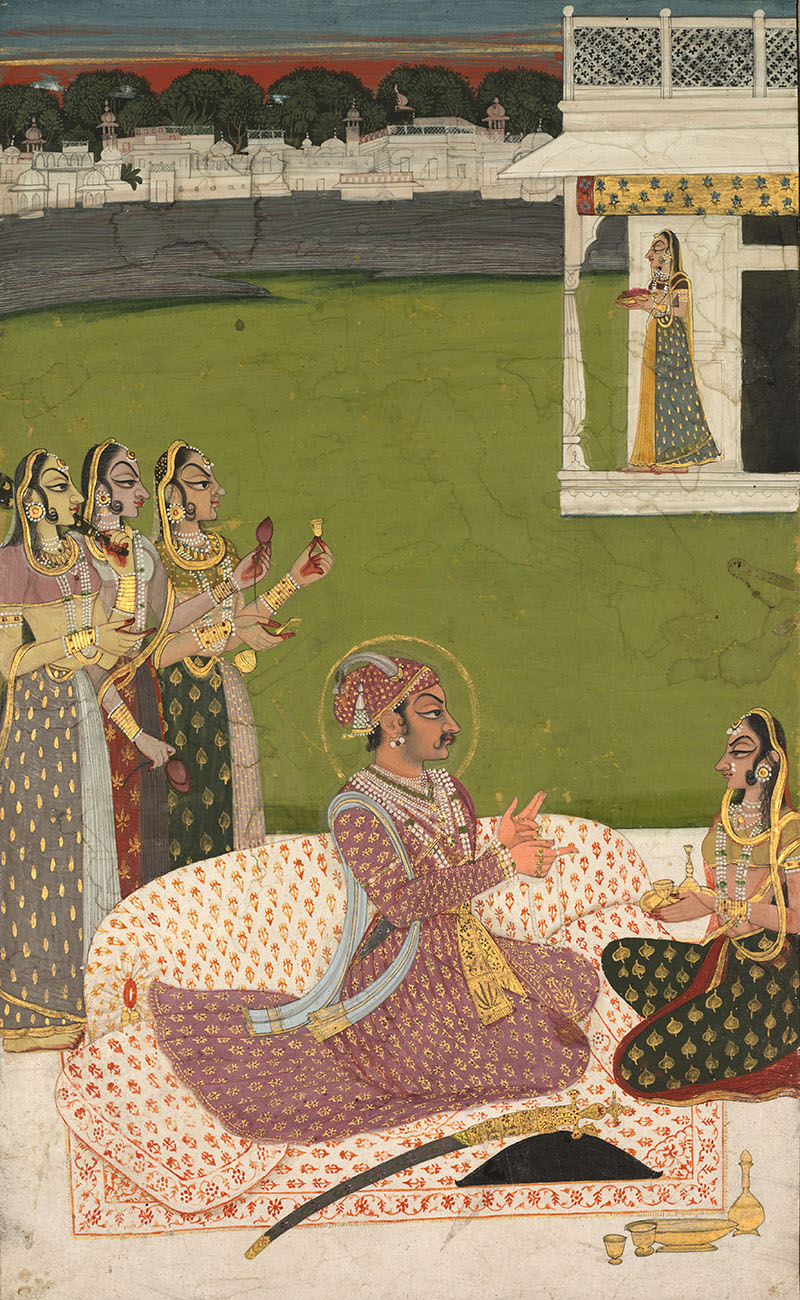A tradition of Rajput painting, the Kishangarh school of painting emerged from the state of Kishangarh in central Rajasthan, from which it also derives its name. It is most notable for paintings from the first half of the eighteenth century, when court artists merged the technical aspects of Mughal painting with a new, idealised representation of devotional figures such as Krishna.
Kishangarh was founded circa 1609 by Kishan Singh, who was the eighth son of Raja Udai Singh of Jodhpur. It is unclear when the court atelier was formed, but a portrait of Raj Singh, the son of Raja Man Singh, dating to 1694 suggests that a court-supported workshop was functional by the second half of the seventeenth century. Court painting went on to flourish in the first half of the eighteenth century, once Raj Singh took over the throne and master artists such as Bhavanidas, his son Dalchand and his relative Kalyanchand joined the atelier at Kishangarh. Besides religious themes, court scenes, royal portraits, and hunting scenes were popular subjects of painting at this time. Bhavanidas, who arrived at Kishangarh after having spent considerable time in the Mughal imperial atelier, became known for experimenting with techniques and themes as well as for his equine portraits. Scholars note that several of the devotional paintings that are considered masterpieces of the Kishangarh school reflect the influence of Bhavanidas, particularly the manner in which he depicted landscapes in his paintings.
The unique style of facial features with which the Kishangarh school is most popularly associated came to the fore in the period between 1735 and 1757. This style is characterised by the depiction of elongated faces in profile, with receding foreheads, sharply defined noses and chins, heavy-lidded eyes and arched eyebrows. Its evolution is credited to the master painter Nihal Chand as well as to the influence of Savant Singh, the heir-apparent and ruler of Kishangarh from 1748 to 1757. Like the previous rulers of Kishangarh, Savant Singh was a strict adherent of the Pushtimarg sect, which centres around absolute devotion to its primary deity Krishna, and penned several religious poems under the name Nagari Das. Thus, while the paintings themselves are credited to Nihal Chand, scholars believe it was due to the patronage of Savant Singh that a new visual treatment of Krishna and scenes from the Bhagavata Purana was developed. Local beliefs also credit Bani Thani, a singer and consort of Savant Singh, as the figure upon which it was modelled. This new facial style was seen as an idealised representation and its use was reserved for depictions of Radha, Krishna and select gopis.
Offsetting the devotional themes of this period are the several humorous paintings and equine portraits also found within the Kishangarh school. The satirical and humorous works served a variety of purposes, from caricaturing a figure to storytelling and moralising. This genre was likely patronised by Savant Singh as well. The culture of equine portraits served both artistic and practical purposes, following the Mughal tradition of portraying animals and doubling as a means of record-keeping. Furthermore, several images of horses produced in the Kishangarh school reflect the stylised and elongated depictions of the physical form that mark its devotional paintings.
Alongside Nihal Chand, several other prominent artists worked in the Kishangarh atelier, such as Amar Chand and Surajmal. Their work, however, suffered when Savant Singh’s position as ruler was challenged by his brother, Bahadur Singh. The animosity between the two eventually resulted in the partition of the state, with Savant Singh’s son, Sardar Singh, ruling the newly-formed state of Rupnagar. Sardar Singh re-established the atelier at Rupnagar and invited Nihal Chand and members of his family to the court. The late-eighteenth and early-nineteenth centuries saw the final phase of the Kishangarh school, under the reign of Kalyan Singh. Notable works executed by court artists such as Ladli Das during this time include commissions of the Gitagovinda and the epic Ramayana.







